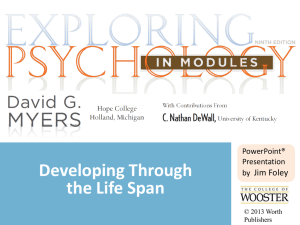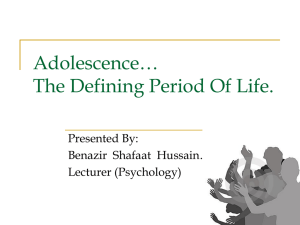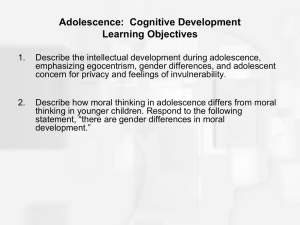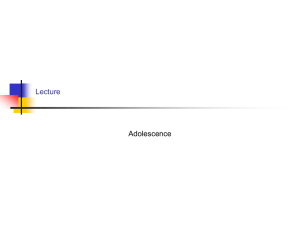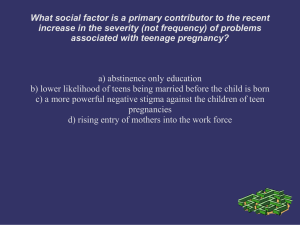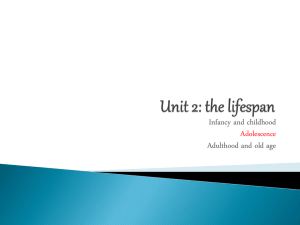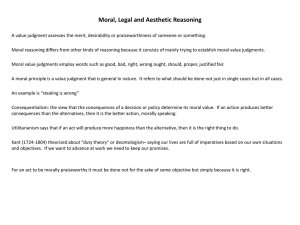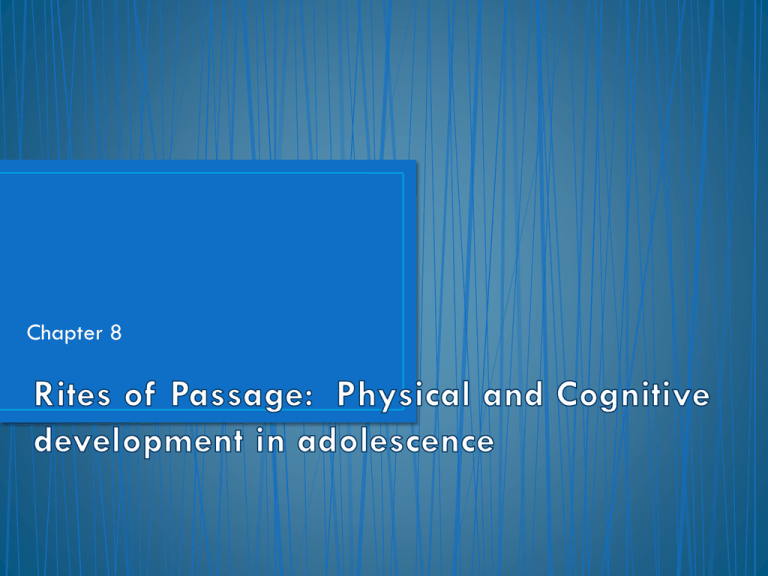
Chapter 8
• Learning Objectives
• What physical changes occur in adolescence that mark the
transition to a mature adult?
• What factors cause the physical changes associated with
puberty?
• How do physical changes affect adolescent’s psychological
development?
• Puberty consists of two changes that mark the change from
childhood to young adulthood
• -Dramatic increases in height, weight, and
• body fat distribution
• -Changes in the reproductive organs that mark sexual maturity,
as well as secondary sexual characteristics such as body and
facial hair, and growth of the breasts
• Adolescence growth spurt
• -Females gain as much as 14-15 pounds in a
• year
•
-begin the growth spurt about 2 years before
•
boys
•
-start at about age 11 and reach a mature
•
stature at 15
• -Males gain around 16-17 pounds a year
•
-start at about 13 and reach a mature stature at
•
about 17
• Hands, feet, and head grow followed by arms and legs, then
trunk and shoulders last
• Bodies are out of proportion briefly
• Bones become denser
• Muscle fibers thicker and denser causing increase in strength
• Body fat increases more in girls
• Heart and lung capacity increases more in boys
•
•
•
•
•
•
Brain is about 95%b of adult size
Myelination almost complete allowing for faster processing
Synaptic pruning almost complete
L:imbic system reaches maturity (reward, pleasure, emotion)
Amugdala more active than in adult brain
Frontal cortex (control of behavior) is still developing, allows
risky behavior
• By the beginning of adolescence the brain is 95% of adult size
and weight
• Myelination and synaptic pruning are nearly complete
• Primary sex characteristics
• -organs of reproduction, ovaries, uterus, vagina, testes,
scrotum, penis
• Secondary sex characteristics
• -physical signs of maturity that are not
• directly linked to reproduction, changes in voice and skin
• -girls
•
-breasts and pelvis width
• -boys
•
- facial hair and broadening of the shoulders
• Menarche
• -onset of menstruation in girls
• -first menstrual cycles are usually irregular
• and without ovulation
• Spermarche
• -first spontaneous ejaculation of sperm
• containing fluid
• -first ejaculation usually contain few sperm
• -sufficient sperm to fertilize an egg may take
• months or years to develop
• Hypothalamus
• -releases hormones to the pituitary gland
• triggering growth hormones
• Pituitary gland
• -stimulates other glands to produce estrogen
• in girls and testosterone in boys
• Timing of puberty
• -genetically regulated
• -affected by health and nutrition
• -Menarche occurs earlier in countries where nutrition
•
and health care are better
• Stress, depression – early menarche
• Harsh punishment as children- early menarche
• Paternal investment theory –
Fathers invested in adolescent – later menarche
Uninvolsed, abscent fathers – early menarche
Psychologically distant or mentally ill fathers compounds
the early menarche effect
• Body image
• -Teenagers are very attentive to physical
• changes, which take place very rapidly and
• are dramatic
• -Girls are more critical of their appearance
• and are likely to be dissatisfied.
• -Boys little influenced by peers but unhappy when do not have
strong masculine body
• Girls
• -prepared by mothers
• -tend to be moderately please
• -irritated by the messiness
• -share the news with their mothers and then
• friends
• -celebrated in other cultures
• Boys
• -less documented reactions
• -usually more pleased if they know about it
• beforehand
• -rarely tell parents and friends
• Moodiness
• -increase in hormone levels are associated
• with greater irritability and impulsivity, but
correlations are small
• -more associated with activities
• -recreational activities associated with good
•
mood
• -adult regulated activities with a negative
•
mood
• Rate of maturation may have a significant consequence for
adolescents
• Early maturation usually benefits boys, but not girls
• -girls had more negative feelings , lack self confidence,
less popular, behavior problems, smoke, and drink,
especially if impoverished and conflict in the home, may be
pressured into sex, lower paying jobs
• -boys tend to have more positive feelings when mature “on
time”. In some studies being early or late can be stressful
•
• Learning Objectives
• What are the elements of a healthy diet for adolescents? Why
do some adolescents suffer from eating disorders?
• Do adolescents get enough exercise? What are the pros and
cons of participating in sports in high school?
• What are common obstacles to healthy growth in adolescents?
• Teenagers need high caloric intake because of high growth and
metabolism needs
• -Girls need approximately 2200 calories per
day
• -Boys need around 2700 calories daily
• Most U.S. teens consume sufficient calories but not balanced,
nutritional meals, may be low on iron causing listlessness and
calcium affecting bone maturation
• -in the U.S. 1 of every 7 children is overweight by body mass index
(ratio of wt to ht)
• -heredity plays a role, may set basal metabolic rate (speed at which
body consumes calories), wt is related to that of parents
• Environment plays a role, TV, parents habits
• Successful programs focus on eating habits and
sedentary behavior
• Success is rooted in monitoring their eating,
exercise, and sedentary behavior. Short term
goals with rewards are set in each area
• Parents are trained to help set realistic goals and
to use behavioral principles in meeting them.
Monitor their lifestyle for enabling behaviors.
• Make healthy foods available and affordable
• Anorexia
• -disorder marked by an irrational fear of being
• overweight
• -have a distorted body image
• -15% of adolescents with anorexia die
• Bulimia
• -binge eating and purging by vomiting or with
• laxatives
• -may occur as many as 30 times per week
• -sometimes cannot stop eating
• Causes:
• Heredity – genes regulating anxiety and food intake
• Psychological factors, hx. of picky eaters, pica, negative self
esteem, mood or anxiety disorders
• * Being overly concerned with one’s body wt. and a history of
dieting.
• Pressure of peers and media
• Overprotective patents risk factor for anorexia
• Childhood obesity risk factor for bulimia
• Sports that emphasize being thin
• Adolescence rarely get enough exercise
• Organized sports
• -more boys participate then girls
• -enhances self-esteem and initiative
• -help learn cooperation and teamwork
• Steroid usage
• -used to enhance performance in sports
• -enhance muscle size, strength and recovery
•
from injury
• -5-10% of boys use steroids
• -Damages lever, reproductive organs, skeleton cardiovascular, mood swings,
aggression,depression
• Regular exercise means 30 minutes three times a week with adolescence
heart rate about 140/min.
• 1 of 1000 U.S. adolescents dies yearly
• -most are results of auto accidents and
• firearms
• -decisions to engage in higher risk behavior
• Adolescents and adults reason out risk similarly
• -the weight given to specific risks may very
• greatly
• -adolescents may give greater weight to the
• social consequences of choices
-illusions of invulnerability
• Adolescents take risks adults find unacceptable
• Learning Objectives
• How do working memory and processing speed
change in adolescence?
• How do increases in content knowledge, strategies,
and metacognition skill influence adolescent cognition?
• What changes in problem solving and reasoning take
place in adolescence?
• For information-processing theorists, adolescence is not a separate
stage
• -rapidly changing transition from childhood
cognition to young adulthood
• -changes do take place in certain areas of
cognitive development
Working memory same capacity as adults
Better able to store info for ongoing
processing
Processing faster ie shorter response
time
Myelination allows faster response and
cognitive processing
• Speed of cognitive processing and memory capacity both
achieve adult levels during adolescence
• Adolescents process information very efficiently
• During adolescence, children become as
knowledgeable as adults in certain domains
• This enhances performance in some areas and
assists them in understanding and learning new
areas
• Adolescents become more skilled at recognizing
and developing strategies for specific tasks and
for monitoring the strategy for their
effectiveness
• They may develop master plans for studying in
school
• Information processing ability increases during
adolescence
• -they may not use these abilities effectively
• -choices may play a role in effective
• processing
• -less mature cognitive processing may be
• used because it is easier
•
• Adolescents more likely to use analysis that heuristics to solve
problems
• Adolescents can discover flaws in reasoning
• Use reasoning skills selectively based on their beliefs
•
•
•
•
Learning Objectives
How do adolescents reason about moral issues?
Is moral reasoning similar in all cultures?
How do concern for justice and caring for other
people contribute to moral reasoning?
• What factors help promote more sophisticated
reasoning about moral issues?
• In response to a story of a moral dilemma, children pass
through these stages:
• -Preconventional Level
• -moral reasoning is based on an external
•
force, reward and punishment
• -obedience orientation is believing that
•
authority figures know what is right and wrong
• -instrumental orientation consists of looking out
•
for their own needs
• Conventional Level
• -look to society’s norms for moral guidance
•
-Interpersonal norm stage
•
-children are guided by winning the
•
approval of others
•
-Social system morality stage
•
-adolescents believe that social roles,
•
expectations, and laws exist to maintain order and are for
the good of all people
• Postconventional Level
• -morals are based on a personal moral code
•
-Social contract stage
•
-laws and expectations are good as long they
•
benefit all group members
•
-Universal ethical principles stage
•
-people choose ethical principles such as
•
justice, compassion, and equality, have a personal moral
system.
• Kohlberg wrote that people progress through the stages in only the
order listed
• Longitudinal studies show that people do not skip stages and do not
regress
• Research demonstrates links between levels of moral reasoning and
moral action
• -Higher levels are associated with causes
• following beliefs. Lower levels are associated
• with delinquency
• Kohlberg theory stresses higher level’s emphasis on
individual rights and justice, reflecting western JudeoChristian values
• The principle reflected in other cultures may be different
and affect resolutions of moral dilemmas
• Eastern culture puts caring for others and familial
obligations above individual rights
• Gilligan argues that Kohlberg’s emphasis on justice is more
applicable to men than women, even in western cultures
• -Primary emphasis for women is caring and
• alleviation of social and global problems
•
-Stage One
•
-preoccupation with one’s own needs
•
-Stage Two
•
-caring for others
•
-stage Three
•
-emphasis of caring in all human relationships and
•
denunciation of violence/exploitation
• Children advance through contact with those in
higher stages
• Kohlberg found that discussion of morality can help
children see short comings of moral reasoning
• Religion affects moral reasoning placing emphasis
on caring for others
• Discussion is best way to help
Children think about moral
Issues in more mature ways


